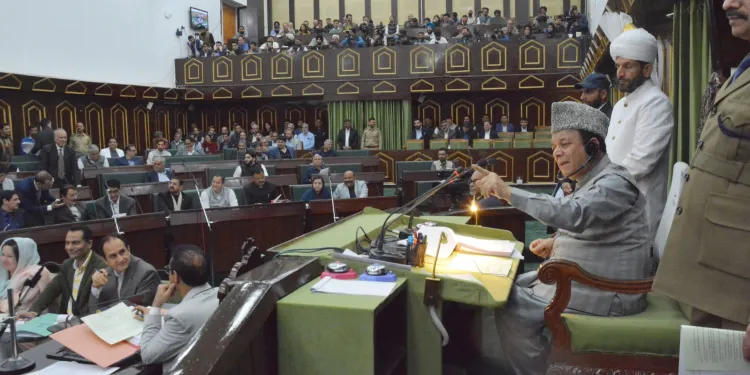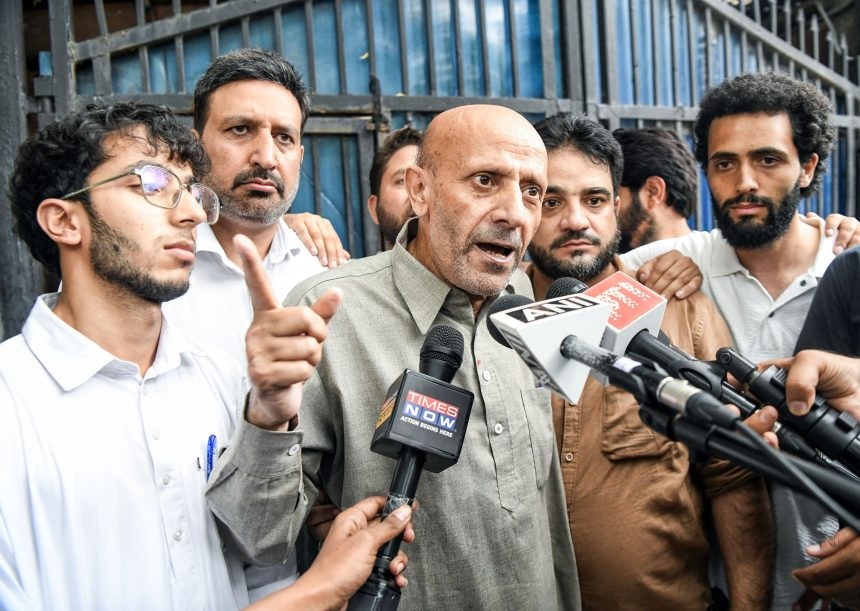What the “7 of 58 resolutions” row reveals about governance, transparency and power in Kashmir
By: Javid Amin | 22 October 2025
In a region where the struggle for representation, autonomy and meaningful political voice remains as pressing as ever, a seemingly procedural row in the Legislative Assembly of Jammu & Kashmir (J&K) has caught the public’s attention. On 22 October 2025, PDP legislator Waheed-ur-Rehman Parra made a pointed claim: of 58 resolutions submitted in the Assembly, only seven were admitted for further discussion; his party’s own resolution seeking to transfer custodianship of the Waqf Board to the Mirwaiz-led Muttahida Majlis-e-Ulama (MMU) was dropped.
On the face of it, this is a technical matter of private-member resolutions and the ballot process. But in the political ecosystem of J&K, it raises far deeper questions: Who really controls agenda-setting in the Assembly? How inclusive is the legislative process? And to what extent does governance in Jammu & Kashmir still reflect meaningful democratic accountability?
This article explores the facts of the row, examines the procedure in the Assembly, delves into the Waqf proposal controversy, and situates it in the wider context of Kashmir’s governance and democratic challenges.
1. The Claim: “Only Seven of Fifty-Eight Resolutions Admitted”
1.1 What Parra said
On 22 October, Parra told the press:
“Only seven resolutions were admitted, and the rest, including our Waqf proposal, were dropped in the ballot process.”
In short: 58 submitted; 7 admitted; the rest rejected or not listed. The resolution in question was the one to hand over Waqf custodianship to MMU.
1.2 Media corroboration
Multiple local news outlets carried the story. For instance, Kashmir Life reported:
“Out of 58 resolutions submitted in the J&K Legislative Assembly, only seven were admitted for discussion. The remaining bills including our Waqf proposal were rejected during the ballot process.”
Kashmir News Service (KNS) ran a similar account.
1.3 Rule-book vs practice
According to Assembly procedure (Rule 28 of the Rules of Procedure and Conduct of Business in the J&K Legislative Assembly), the process for private-member resolutions typically includes:
-
Submission of resolutions by MLAs
-
Admission by the Speaker/Secretariat if they meet criteria
-
Balloting among admitted resolutions to determine precedence and if listed for discussion
Some key details gleaned from reporting:
-
The Speaker in March 2025 stated that the Secretariat received 111 resolutions from 34 members, of which 87 were admitted for balloting and the rest disallowed.
-
On the current controversy, no full official bulletin has been publicly published listing all 58 and which 7 were admitted.
1.4 The procedural gap
What remains unclear:
-
On what basis the other 51 resolutions were excluded or not admitted
-
Whether “admitted” means listed for debate, or merely entered into the ballot
-
Whether individual MLAs were informed of non-listing and given reasons
Parra and others argue there is a lack of transparency in the process. In an earlier incident, when a PDP resolution sought to declare 13 July a holiday, the Speaker clarified it was admitted but did not secure precedence in the ballot.
2. The Waqf Proposal: Custodianship, Reform and Rejection
2.1 What was the proposal?
The PDP resolution sought to transfer custodianship of the Jammu & Kashmir Waqf Board to the Muttahida Majlis-e-Ulama (MMU), an influential religious umbrella organisation headed by the Mirwaiz of Kashmir. Parra said this move aimed at reforming governance of the Waqf endowments, an issue of religious, communal and socio-economic importance.
2.2 Why was it significant?
-
Waqf endowments are major socio-economic assets: mosques, shrines, schools, land, revenue.
-
In a Muslim-majority region like Kashmir, the structure and custodianship of Waqf affairs matter politically and socially.
-
The PDP, traditionally strong in South Kashmir and among Shia voters, sought a leadership role in Waqf governance via MMU.
-
The resolution also had symbolic weight: a statement of local control, religious autonomy and reform in a region where endowment governance has been criticised for lack of transparency.
2.3 Why was it rejected (or not listed)?
According to Parra and other observers:
-
The resolution was dropped in the ballot process — despite being among the submitted 58.
-
No public explanation was issued for its exclusion.
The Speaker, however, contended in earlier unrelated matters that “admitted” does not guarantee listing and the failure to secure a ballot slot is not “outright rejection”.
2.4 Political fallout
-
The PDP used the rejection to argue that the Assembly’s private-member resolution process is tilted against reform-oriented or opposition proposals.
-
The NC-Congress coalition faced criticism that it prioritises internal decision-making over inclusive legislative debate.
-
Religious and community groups voiced concern that endowment governance remains under opaque administrative control rather than transparent board management.
3. Governance & Democratic Transparency in J&K’s Assembly
3.1 Power structure in J&K
Since the 2019 abrogation of Article 370 and the reorganisation of Jammu & Kashmir into a Union Territory, the region’s governance is characterised by:
-
An elected legislative assembly (since 2024)
-
A Lieutenant Governor with significant administrative and special powers
-
An executive often seen as constrained by centre-state dynamics
In such a framework, the legislative assembly’s role becomes both symbolically and practically important for local democratic legitimacy.
3.2 Why procedural transparency matters
When MLAs submit resolutions and only a few are admitted, the following questions arise:
-
Who decides which resolutions get precedence and why?
-
Are the criteria applied uniformly?
-
Does the process allow meaningful scrutiny or become tokenistic?
-
For minority regions and special-status constituents, does the process reinforce or mitigate marginalisation?
3.3 The “Seven of Fifty-Eight” row as exemplar
By raising the figure — seven admitted out of 58 — Parra triggered broader unease:
-
Voters realise that submitting a resolution is not enough. It must survive admission and balloting.
-
The lack of publicly published lists signals accountability deficit.
-
In a region where trust in institutions is fragile, perceptions of exclusion risk further alienation.
3.4 Implications for governance
-
If only a small fraction of proposed bills/resolutions succeed, MLAs might become less inclined to table reform-oriented resolutions.
-
The executive (government) may continue to drive agenda via official bills, limiting the opposition or independent voices.
-
For issues like Waqf governance, civil liberties, land rights — where reform is critical — this can freeze legislative action and dampen public hope.
4. The Broader Political Context: Kashmir’s Democratic Challenge
4.1 The promise and the practice
The return of an elected legislature in 2024 raised hopes: increased local autonomy, improved representation, renewed trust.
Yet, one year in, observers note several trust gaps:
-
Slow progress on major manifesto pledges (e.g., statehood restoration, employment, autonomy)
-
Electoral participation struggling in some areas
-
Emerging discontent over performance versus rhetoric
4.2 The role of legislative debate
In this context, the Assembly should serve as:
-
A forum for diverse voices (majority, minority, youth)
-
A check on executive power
-
A platform for reform
When procedural mechanics limit admissibility, the legitimacy of this institutional role is weakened.
4.3 The Waqf governance lens
Endowments and religious asset governance have become contested terrain in Kashmir:
-
How local communities manage land and religious property is intertwined with identity, autonomy and economic rights
-
The rejection of the Waqf custodianship resolution therefore resonates beyond religion: it touches who governs what, how asset value is used, and who benefits.
5. What Does This Row Reveal?
5.1 On legislative process
-
Admission and balloting rules exist but appear opaque to many legislators.
-
The low admission rate (7/58) suggests either stricter vetting or politically influenced filtering.
-
Public access to list of admissible vs rejected resolutions remains weak.
5.2 On internal party-politics
-
The PDP’s public airing of grievance suggests frustration not only with government but also with intra-assembly norms.
-
It may signal that the NC-Congress coalition lacks internal coherence in legislative agenda-setting.
5.3 On representation & inclusivity
-
MLAs representing smaller communities or reformist agendas may feel short-changed if procedural hurdles persist.
-
The Waqf issue highlights how religious-asset governance intersects with democratic accountability in Kashmir.
5.4 On public perception & trust
-
The public may perceive the Assembly as a formality rather than a meaningful deliberative body.
-
When reform-oriented resolutions get no hearing, voter cynicism may deepen further.
6. Charting Next Steps: Reform & Oversight
6.1 For the Assembly
-
Publish the complete list of submitted resolutions, and mark which were admitted, balloted, listed or rejected.
-
Provide criteria and reasons for non-admission or non-listing in easily accessible form.
-
Increase public visibility of private-member resolution outcomes.
6.2 For political parties
-
Push for internal discipline to ensure MLAs who submit resolutions are informed of their fate.
-
Oversight by parties (whether in government or opposition) can keep the process accountable.
6.3 For civil society & media
-
Monitor the filtering process of resolutions and whether certain topic-clusters (e.g., land rights, religious assets, civil liberties) are disproportionately blocked.
-
Publish data analyses on admission/disapproval rates over sessions.
6.4 For governance in J&K
-
Use this controversy to spark legislative reform — procedural transparency can strengthen institutional trust.
-
Recognise that reforms aren’t just symbolic; they matter for faith in local institutions.
Bottom-Line
What began as a slip of the tongue — “only seven of fifty-eight resolutions admitted” — is fast becoming a mirror of Kashmir’s deeper democratic challenges. The legislative assembly isn’t merely a venue for show-debates; it is a vital piece of governance architecture. When procedural mechanics fail to reflect the hopes of reform-oriented MLAs or upset community stakeholders like the MMU/Waqf bodies, the credibility of the institution erodes.
The Waqf custodianship resolution, now a flashpoint, is more than a religious governance matter — it is about who decides, how transparently, and whether the promises of representation matter.
For Jammu & Kashmir’s fragile democratic fabric, the sign-of-the-times is plain: good governance is not limited to slogans, but also to open, robust, inclusive legislative practice. If that gap is bridged, then the “seven of fifty-eight” debate might prove to be a turning-point. If not, it may become yet another chapter in frustration, faith lost and trust deferred.



